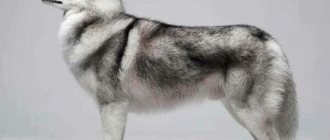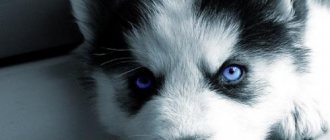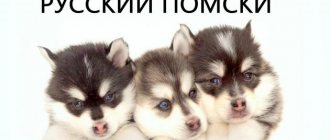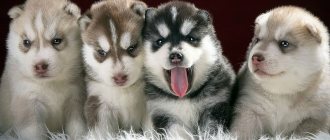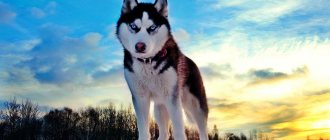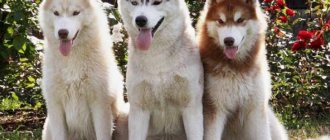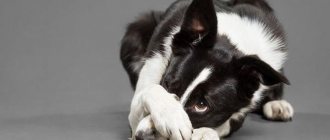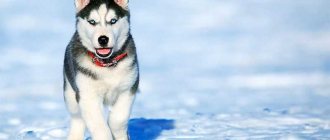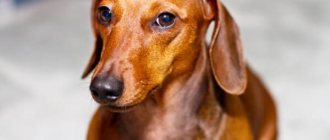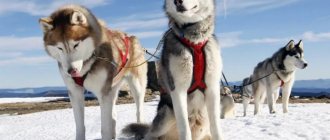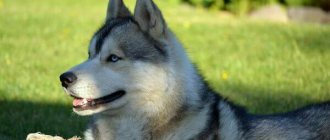Dossier
Adult height: 55-70 cm. Weight: 30-40 kg. Characteristic color: varied. The tiger color is especially prized. Coat length: short, medium. Life expectancy: up to 15 years. Advantages of the breed: calm, balanced dogs with high intelligence. They are distinguished by powerful muscles and strong bones. Difficulties of the breed: it is on the verge of extinction. Average price for a Sakhalin Husky puppy: from $400 for culling to $2000 with pedigree. Classification: large breed, working, sledding, hunting.
Performance evaluation and information
Individuals of this breed are quite large in size and weight. The average adult dog reaches a height at the withers of up to 70 cm, while its weight can be about 30-40 kg. Such a large body structure was noticed by man since ancient times, so ancient tribes began to domesticate the breed.
Thus, this animal became one of the oldest domestic animals ever used by man.
Did you know? For the first time, northern huskies were tamed by the northern people called “Nivkhs,” who lived in the Amur region 11 thousand years ago.
The breed's physique is appropriate - its body is quite powerful and large. The dog has an elongated body, the strength of which is maintained thanks to a strong skeletal system and developed muscles.
All representatives have small ears, pointed at the tip, and their position is slightly tilted forward. The husky's limbs are also large and powerful; with their help, the animal can overcome any physical activity without much difficulty.
This northern dog has thick fur. The undercoat is particularly dense, but the front part of the body and the front part of the paws are less covered with hair. The color of the breed can be varied. Most often there are spotted patches on the body; very rarely the color can have a uniform structure.
When it comes to coat colors, several shades can predominate here: white, black, red or gray. Animals with a tiger color have the greatest value (especially among the natives of the Amur region).
History of the origin of the breed
An ancient breed of sled dogs was developed in Japan. Dogs are often called Gilyak Husky, Sakhalin Dog (“Karafuto Ken”). The breed has long been used by the population of Sakhalin (Nivkh and Gilyak people) for sledding in deep snow and hunting bears and sea animals.
Today the breed is on the verge of extinction (in 2014 there were only 7 individuals). Japanese breeders took up the task of preserving the Sakhalin Husky, and the dog was included in a special restoration program in the Land of the Rising Sun. On Sakhalin, a sled dog is called a husky, and a hunting dog is called a husky.
Story
The history of the Husky goes back further than the history of native peoples and whale hunting. The peoples of the mouth of the Amur and Sakhalin, the Nivkh and Gilyak tribes used dog sleds as transport. Only she could help transport the caught fish to the parking lot. Man stocking fish for the long winter always left part of the catch for the dogs.
The Sakhalin Husky was formed by nature itself. Its other names are the Gilyak Laika or Karafuto Ken, which means “Sakhalin dog” in Japanese.
In the pre-war years of the 20th century, the dog was highly valued for high-speed postal services. Only the Sakhalin Husky and the Siberian Husky could reach camps and expeditions in winter. The sleds were successfully used in units of the Red Army. In the conditions of the north, military cargo was delivered quickly to the desired point, only by dog sleds. Husky is deservedly considered one of the best sled dogs.
With the development of the harsh region and the advent of modern means of transportation, the development of small aircraft, the need for dogs almost disappeared. And the breed practically disappeared. According to Wikipedia, the last Russian breeder and major specialist in this breed died in 2014. That year there were only seven purebreds left.
Currently, Japanese cynologists are trying to revive the breed. The history of Japan is inextricably linked with the Far East and at present a pure line has been preserved there, which is believed to have much in common with the Sakhalin dog. Akita Inu and Sakhalin Husky most likely have common, not very distant roots. The Japanese Husky is not much different from its northern counterpart and successful selection is being carried out on its basis.
Purpose of the breed
The Sakhalin Husky is distinguished by its enormous endurance, thick dense fur, excellent muscles and large paws. Thanks to these distinctive features, the breed is ideally suited for living and working on a harsh island. The closest relatives are the Alaskan and Siberian huskies, a hybrid Klee Kai. The species have similar appearance and behavior, but there are differences in characteristics.
The differences between the Sakhalin and Siberian huskies are that the island breed has a stronger bone structure, is distinguished by its larger size (10-15 kg heavier and 5-10 cm taller) and thick coat with longer guard hairs. Today the dog is kept as a pet.
Interesting Facts
A stuffed Sakhalin husky named Jiro is in a museum in Tokyo.
In February 1958, Japanese researchers, due to an emergency situation, left 15 Sakhalin huskies in Antarctica with a small supply of food, hoping to pick them up soon, but the weather deteriorated very badly, and they were unable to do this. Therefore, people returned there only almost a year later - January 14, 1959. Incredibly, they found two miraculously surviving dogs. These dogs became heroes and also brought enormous popularity to their breed. This event served as the basis for the film "Antarctica" (also known as "Antarctic Story") (eng. "South Pole Story" - Nankyoku Monogatari (南極物語) in the American box office: "Antarctica" - 1983 directed by Koreyoshi Kurahara. Later based on this film , as a remake, the American film White Captivity was shot. In honor of the dead dogs from this expedition, a monument was erected in Japan using public money.
13 dogs were found dead: Goro, Besu, Moku, Aka, Kuro - never left their leash; the bodies of Bochi, Kuma, Riki, Anko, Shiro, Jakku, Deri, Kuma (another) are lost at sea; 2 - found alive: Taro and Jiro.
It is unclear how the dogs were able to survive, since, according to experts, the average husky can live in such conditions for no more than 2 months; the food left at the base was all eaten by Taro and Jiro. Subsequently, their destinies diverged. Jiro died in Antarctica two years later on the 5th expedition in July 1960. Taro was taken to Sapporo, to Hokkaido University, where he died at the age of 20 in 1975. The taxodermic remains of the heroes were exhibited as museum exhibits. Taro is at Hokkaido University, and Jiro is in Tokyo, National Science Museum, in Ueno Park, next to the stuffed animal of the famous Hachiko.
The names of fifteen Sakhalin Husky (Karafuto-ken) sled dogs that participated in the 1958 Japanese expedition:
1. Ricky: 7 year old male with light gray coat and white markings, leader of the team. (Missing)
2. Anko: Three-year-old male with a brown coat and a white stripe on his chest. (Missing)
3. Aka: A six-year-old male with a dark gray coat who tended to pick fights with other team members. (Dead)
4. Kuma by Monbetsu: Five-year-old male with black coat, white socks and white chest, sometimes served as lead dog. (Dead)
5. Kuma by Furen: Five-year-old male with black skin and spots - a white spot on the chest. Father of Taro and Jiro. (Missing)
6. Peku: Five-year-old male with a brown coat, black mask on the face and black ears, similar to the Belgian Tervuren. (Dead)
7. Goro: A four-year-old male with a black coat and a white stripe on his face, similar to a collie. Served as the “wheels” of the dog team. (Dead)
8. Deri: a six-year-old male with a gray coat and a black saddle (back?). (Missing)
9. Bochi: A four-year-old male with a light brown coat and a voracious appetite. (Dead)
10. Moku: Four-year-old male with a black coat and white socks on his front legs. (Deceased)
11. Jaku: A four-year-old male with a black and white coat that almost resembles a collie. (dead)
12. Kuro: A five-year-old male with a black coat and white markings on his face, chest and legs. (Dead)
13. Shiro: Three-year-old male with a snow-white coat, sometimes served as a lead dog. (Missing)
14. Taro: Three-year-old male with black skin. Son of Kuma by Furen and older brother of Jiro. (Survived)
15. Jiro: Three-year-old male with a dark brown coat, a white patch on his chest, and white socks. Son of Kuma by Furen and younger brother of Taro. (Survived)
Character
The Sakhalin Husky is very calm, balanced, distinguished by high intelligence and the same endurance. But at the same time playful and active. Dogs of this breed took part in battles during the Red Army and were part of an expedition to Antarctica.
The breed is very friendly, calm towards other dogs, fearless and hardworking . Due to the fault of man in the 30s of the last century, the breed was on the verge of extinction: on Sakhalin, a reward was announced for the skin of huskies, which were killed like wolves. It was this genocide that led to the deplorable situation with the number of dogs.
Breed varieties
Among the descendants of the ancient breed, several varieties can be distinguished:
- Koi-kai is the smallest of the genus. It can hardly be called a sled dog, but it is very suitable for home keeping.
- Alaskan, mestizo, who have quite a lot in common with their Sakhalin brother. Considered the fastest sled dog.
- Sakhalin, mother breed. Currently on the verge of extinction.
- Siberian, the most common in the breed. Unfortunately, she no longer has the same qualities of endurance as the Sakhalinskaya.
- The Japanese one is good for everyone, but has already lost the habit of running and can hardly be seen in a harness.
How to choose a puppy
To purchase this rare puppy, it is better to contact certified nurseries or reputable breeders. The most appropriate age to evaluate a puppy is 8 weeks. At this age it is already possible to judge the proportions and shape of the head and the entire figure, the correctness of the bite and compliance with breed standards.
They take the puppy into the home at the age of about 2 months (a little older), it is recommended to pay an advance payment for the chosen baby in advance and visit him as he grows up. Get a pedigree, a veterinary record for the dog, a vaccination card, dates of anthelmintic measures, a purchase and sale agreement, a document about registration in the RKF (or foreign community).
Pay attention to compliance with the breed description:
- The head is large, with a pointed muzzle.
- The ears are triangular, erect, and set high.
- The eyes are almond-shaped, slightly slanted.
- The limbs have good muscles, the paws are large, designed for moving on crust.
- The tail is straight, long, densely covered with hair.
Husky puppies
It is important, when getting a husky puppy, to clearly define the purpose for which you are getting this particular breed of dog. The choice needs to be clear - whether it will be a friend in the family or to participate in exhibitions. This decision will be the key point in the method of raising a pet.
By nature, Husky puppies are social lovers, so being alone is not the best environment for them. If the puppy is left alone, he will wait for you all day and “cry”. It is best to purchase a puppy from a person who raises them in a family environment. Such kids are better socialized and amenable to training.
To determine what the character and appearance of your pet will be as an adult, you need to take him no earlier than 8 months. It is from this age that all the nuances of character appear, and all bodily defects are visible.
This is very important, since for show huskies the most important condition is ideal appearance. But, although at this age it is already possible to notice something, you still need to take into account the fact that as the animal grows, it can change.
Care and maintenance
The breed is not suitable for keeping in an apartment. It is best to keep Karafuto Ken on the street or in a country house. When placing a dog in the yard, you need to think carefully about its placement - the dog cannot stand the heat and, due to its love of travel, is inclined to run away. Please note that if you give your pet little attention, he will howl, disturbing his neighbors (genetic inheritance from the wolf).
- The dog is unpretentious in maintenance and care, is clean, and has almost no dog smell.
- Long walks with heavy physical activity are recommended, at least 2 times a day for 1 hour or more. During the hot season, they walk in the early morning and evening. In hot weather, be sure to take water with you for your pet.
- Coat care - brush your husky once a week; during shedding (twice a year for about 3 weeks), use a slicker to remove dense, thick dead undercoat. When a husky sheds, brushing is done twice or thrice a day.
- Huskies are bathed once a year, and the rest of the time they wipe dirty areas with a damp sponge.
- Ear care - once a week, wipe with a damp cotton pad or swab dipped in hydrogen peroxide.
- Eyes are rubbed as needed.
- Feeding – premium, “Superpremium” dry food with a low content of plant components. The animal’s diet includes fish, stringy lean meat, offal, eggs, cottage cheese, fruits, and vegetables. You cannot feed your dog from the table; it is prohibited from eating smoked, salty or sweet foods.
- Drinking regime – without restrictions. Huskies should always have access to clean drinking water.
Caring for a Siberian Husky
Important: The Siberian Husky is not an apartment dog! Although in some cases she feels quite comfortable in apartment conditions. The dog is not particularly whimsical. Historically, in ancient times, dogs of this breed were fed once a day and then with sea fish, so whimsical eating was not noted.
It is necessary to highlight the advantages of keeping this dog:
- The animal does not leave salivary secretions behind;
- Almost complete absence of characteristic odor;
- Molting occurs 2 times a year, not pronounced;
- No special care required.
The Sakhalin Husky breeder needs to learn simple rules of keeping:
- It is necessary to comb the animal regularly with a thick comb;
- Daily brushing of teeth;
- Check your dog's nails and pads daily.
It should be noted that bathing is not a very important matter for a husky. This procedure should be carried out no more than once a year. As for pure white dogs, more frequent bathing is allowed, but not too much.
This is due to the fact that the dog’s coat is not adapted for this. If this simple rule is not followed, then you may encounter skin problems such as dermatitis and fungi. The bathing procedure can be completely replaced by wiping the paws and belly with a sponge moistened with water.
A dog's ears are one place that needs to be given a lot of attention when grooming. Since the ears are a weak point, they need to be cleaned weekly with cotton swabs. Before the procedure begins, the stick is moistened with either water or a solution of hydrogen peroxide.
Huskies are very clean by nature, which makes the process of caring for them much easier.
Training
The husky, bred for work, is today kept as a family pet. Sakhalin Huskies are very smart and self-sufficient, so they are difficult to train in the initial stages. Later, learning becomes easier. Home education should begin from the first days a husky baby appears in the house. It should be systematic and methodical with the inclusion of instructive games. The carrot-and-stick method doesn't work.
It is important that the baby understands that the leader of the pack is his owner. The system of punishment and harsh treatment is prohibited.
During walks, visit new places, engage in active games, so that your pet satisfies its thirst for adventure and exploration, and receives sufficient physical activity. It is better to walk your husky on a leash and, only after making sure that he is completely obedient to you, let the puppy run freely.
Training and training of the Gilyak Laika
Training and education for this type of husky is quite difficult. A dog is a self-sufficient entity, so instilling obedience in it is actually a difficult task, especially in the initial stages.
Sometimes the trainer has to ask the animal to execute a well-studied command 10-15 times before the animal executes it. However, the dog is not an obstinate creature and is quite trainable. But, in order for it to be effective, the dog must undergo training in a special school, under the supervision of an experienced specialist.
To care for this dog you will definitely need a furminator.
Also, in order for the achieved successes in correct behavior to remain in place, there must be a single line of behavior in the dog’s family. All family members should praise or scold for what they have done; diverse behavior will have a detrimental effect on the dog’s behavior.
In addition, the well-known “carrot and stick” method in teaching him is not appropriate. The animal will not tolerate physical punishment, and if it is carried out frequently, it may even register the owner as an enemy. Praising an animal for correct behavior will have a much more effective effect on the animal.
It is also important to remember that the Sakhalin Husky constantly strives to dominate the family, even at a very early age. Therefore, it is important to stock up on special endurance, since only in this case will you be able to raise and train this dog.
Advantages and disadvantages
The Sakhalin Husky is very smart, calm, loyal and reserved. This dog is well suited for a balanced, cold-blooded person. The breed does not require special care, it does not require large financial expenses for maintenance, and the dogs are clean. However, it is necessary to have a large amount of free time for long walks with your pet , for activities and games with it.
Have you met representatives of this endangered breed? What behavior did the Sakhalin Huskies you saw differ in?
Which owner is it suitable for?
Despite the fact that the breed is a calm and friendly dog, the Karafuto-ken is not suitable for all animal lovers. A dog always has his own opinion on everything. Therefore, in order to raise a docile and obedient animal, the dog must know who is boss in the house. He can only get along with a strong-willed person who has a strong character.
However, the owner must have a huge amount of patience, since the animal can often react passively to commands (especially in its youth), so people with an impulsive character are better off turning their attention to other breeds.
Although at first glance the animal looks lazy and clumsy, it loves active recreation and walks in the fresh air. Since the dog is a riding animal, the amount of physical activity for it should be organized to the maximum.
Important! Constant power loads are mandatory for the Sakhalin Husky. Otherwise, the animal will begin to feel severe stress and serious health pathologies may even appear.
Only in this case will the pet be happy and satisfied with life. Therefore, if you do not have enough time for long walks, or you do not like an active way of life, the Karafuto-ken will not get along with you.
